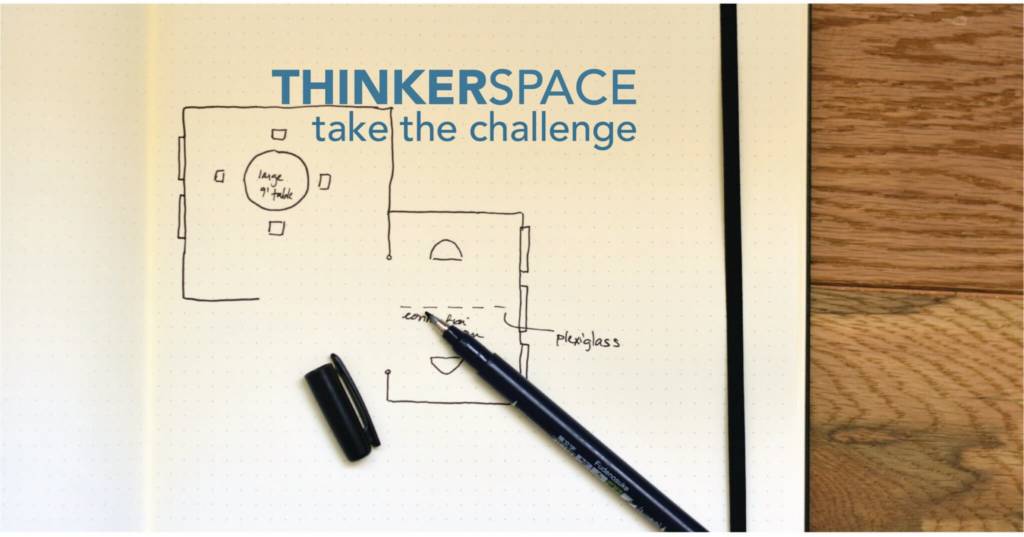White Water Rafting: A ThinkerSpace Challenge to Keep You Cool
If you’ve been following our Facebook page, you’re familiar with our ThinkerSpace Challenges. These challenges are designed to engage students and your own children in project-based learning. As I write these challenges, my goal is to make sure kids can complete each challenge by using materials they can find around the house.
This week’s challenge will keep your kids cool as they design and test raft designs.
The Engineering Design Process
We recently used the Engineering Design Process to focus on iteration—Test and Improve. Today, we’re going to move to the Ask and Research steps.

In these steps, students ask questions about the challenge. They identify needs, constraints, and any potential difficulties they might encounter. Then they conduct research so they can better understand which factors could positively or negatively influence the outcome.
White Water Rafting
If you’ve ever gone white water rafting, you know that it’s a dangerous activity. The design of the raft must keep the rafters afloat and remain intact despite going over rocks.
Safety is crucial to the design of any watercraft, whether it’s for white water rafting or to ford the Kansas River. (If you’ve ever played The Oregon Trail, you know how important it is to have a solid design!)
In this challenge, your students will build a watercraft. They can build one for an extreme sport, like white water rafting, or choose a different purpose.

Build a Raft
Design a raft or other watercraft that ensures the safety of its passengers and meets all necessary requirements. How will you make it stay afloat?

A successful watercraft is one that can float. But how is that accomplished?
Similar to the Paper Airplane Challenge, your students must be aware of different forces—gravity and buoyancy—and how they’ll impact the design.
- Gravity: Gravityplaces a constant downward force on the boat.
- Buoyancy: Buoyancy is an upward force created by the weight of water that is displaced, or moved, by the part of the boat that’s under water.
For a typical watercraft, like a canoe or a boat, part of the boat is actually below the water’s surface. This part of the boat is called the hull. In order to stay afloat, the boat must weigh less than the amount of water that’s displaced (or moved) when it’s put in the water.
The shape of the watercraft and materials used to build it can ultimately determine whether or not it floats. If you use lighter materials and design a hull that displaces more water, your boat can carry more cargo.
Learn more about how boats float here.

As you start designing your raft or other watercraft, consider these questions:
- How will this watercraft be used? What are the constraints? What is important to incorporate in your design? What outcomes are needed?
- What materials will you use?
- How much weight does the watercraft need to carry? (Think people, equipment, etc.)
- How much will the final design, including people and the objects onboard weigh?
- How will your design keep passengers safe if there are rough water conditions or obstacles like rocks and fallen trees?
- How can you test your design in these conditions?

Let’s get started with your challenge.
- Before brainstorming your design, make sure you fully understand the design requirements and constraints.
- How will this watercraft be used? What are the constraints? What is important to incorporate in the design? What outcomes are needed?
- Begin designing your watercraft. Once you have an initial design, review the requirements and constraints to ensure you’ve met all of them.
- Develop a prototype of your watercraft.
- Track the amount of material you use and the dimensions of your prototype. This information could be helpful when you enter mass production or compare iterations with your initial design.
- Test your prototype. If you can’t test with a full-size prototype, simulate its function with a scale model.
- Try to replicate the conditions (water movement, weather, obstacles) that your design will face when it’s used.
- Revise your design until it meets all of the requirements and constraints for its purpose.
- You should be able to explain how your design meets those parameters.
- Share your design with friends, family members, or invested stakeholders.
- If you’re trying to find investors for your invention, be ready to explain the science and math behind your design. Investors will want to know how much it would cost to produce, how it will keep passengers and cargo safe, and why people will want to buy it.

Start by exploring the buoyancy of objects. Ask your students to collect a number of objects and test whether they sink or float. Invite them to compare objects and figure out why they float. Next, ask them to apply what they learned to build a raft or boat that can carry an object. You can assign an object that represents cargo or have them choose another object. Keep in mind what materials are available at home.
To make this experience more rigorous and realistic, apply the challenge to a real-world problem or need. This could mean that you apply constraints for materials the students can use, limit the quantity or cost of the materials they use, or ask students to answer questions about how the watercraft will be used.
Have students test their design and explain why it did or didn’t work. Encourage them to improve their design and test it again. Spend time discussing each student’s design and how it works.
Opportunities for Skill Application
Last week, we discussed how The Big Ride Challenge could reinforce mathematical practices. This week, consider how this challenge could help students focus on entrepreneurship.
Entrepreneurship is defined as the process of combining resources in a new or innovative way to add value and take advantage of the opportunity to make a profit.
By engaging students in entrepreneurship, students develop valuable skills like collaboration, communication, project management, innovation, and being able to create valuable, effective solutions for real-world problems.
Take a look at this origami-inspired kayak. The inventors of the Oru Kayak identified a need for a one-person watercraft, after all, many people don’t have vehicles large enough to transport a kayak or the strength to lift one onto the roof of a car. The kayak inventor, Anton Willis, combined the art of origami and principles of kayak design to create a solution to a real-world problem. This is the epitome of entrepreneurship.
As your students and children complete this ThinkerSpace Challenge, ask them to broaden the reach of their innovative design. How can they turn their design into a profitable business? How can they adjust the functionality to find an opening in the market?
Learn more how entrepreneurship can impact your students’ beliefs about their future.
In any design challenge, it’s essential that your budding engineers understand the constraints and needs for the design. This shift from self to potential client or end user will help develop empathy for others’ needs and feelings. Turn water play into an opportunity for entrepreneurship with this ThinkerSpace Challenge!



